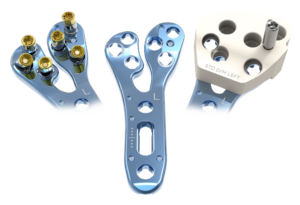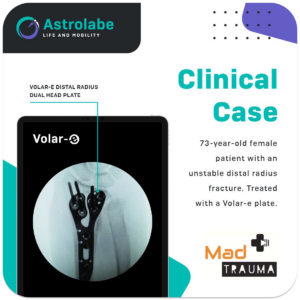The wrist is one of the most complex joints of the human body. It is the ultimate positioner of the hand in this long multi-articulated effector mechanism that the upper limb is.
Fracture of distal radius occurs in the metaphyseal region, so, bone healing generally takes place. An anatomical reduction allows recovery of wrist function.
This system is intended for temporary fixation of complex intra and extra articular fractures and osteotomies of the distal radius, correction, and stabilization of bones with help of anatomically shaped plates and screws such as, cortical screws Ø2,4; cannulated screws Ø2,7; variable angle locking screws Ø2,4 & Ø2,7; variable angle locking pin Ø1,8.
With the broad plate range that Astrolabe offers for varying wrist anatomy and fracture patterns, reduction and fixation can take place with reliable and repeatable optimal results.

The Volar-e system provides the following features:
– Various head widths, narrow, standard and wide for the different radius anatomy;
– Two head types, standard and dual head;
– Various shaft lengths, 3, 4, 7, 12 and 14 holes for radius;
– Various shaft lengths, 3 and 5 holes for ulna;
– Longer plates (12 and 14 holes) shaft can be bent off of the original geometry with help of bending notches;
– Holes for the fixation of radial styloid and support of lunate facet and distal radioulnar joint;
– Undercuts along the plate for reduced plate-to-bone contact;
– Tapered and narrowed proximal end to facilitate insertion and reduce soft tissue irritation;
– Oblong screw slot for reduction for the fracture with measurement;
– Multiple guiding system, PEEK guiding block and individual guides;
– K-Wire holes for preliminary plate fixation;
– Suture holes for fixation of soft tissue;
– Hook to catch fragments;

This new design provides the ideal anatomical shaped that fits close to the volar ridge keeping always in mind the principal of rounded atraumatic plate contour and minimal thickness in specific areas to minimize the contact with soft tissues and assure the best possible embedding.
In a case study we shared on our social media from our partners we can see a 73-year-old female patient sustained an unstable distal radius fracture, which was treated with a Volar-e distal radius dual head plate.
Thanks to this treatment, the patient will be able to move her hand in just a few days.
We can conclude that the most efficacious method for treating unstable fractures of distal radius with volar displacement is an open reduction followed by internal fixation with a supporting plate and the specifications of the Astrolabe’s Volar-e plates gives a wide range of plates for any type of fracture and wrist anatomy.



